How Thick Should a Concrete Sidewalk Be?
Important Point
The consistency of sidewalks should be at least 4″ to 6″ depending on the burden and soil conditions. 4″ are the authoritative benchmark. Nearly all of the sidewalks and frail boards we lay are 4″ thick common.
Although we do pour the edges a little bit thicker which helps prevent cracking. It’s generally called a thick bite. In areas where the soil is strong and the footing is well compacted, 4 elevation is generally thick enough for standard use similar to walking and cycling.
Still, if you reside in an area with bad soil that can sink over time, we recommend pouring at least 6″ of concrete to help to crack. also, you should call an amplifier.
However, 6 elevation is presumably stylish, If you’re utilizing rebar or like quicksand. But if the underpinning is grittiness or helix micro rebar, you can pour 4″.
Bikes, skateboards, maunderers, and scooters all roll painlessly on smooth concrete sidewalks. Sidewalks come in numerous designs and sizes but are frequently made of concrete.
As a common principle, the optimal consistency for concrete pavements is 4″ for sidewalks and 6″ for passing instruments or when underpinning is demanded any argument. Pavements in front of roads, places with infelicitous soil, places apt to buckling, etc. Pavements must be thick enough to repel loads and strong enough to repel cracking and corrosion. Concrete is the most common or garden.
The substance we exercise in the construction of sidewalks and walkways. This concrete is accessible, looks great and is veritably strong and dependable. It’s also a veritably protean structure substance that works in all rainfall conditions and looks great in nearly any phraseology of home. Special pavement density is detailed below.
Also Read: How to Cover Concrete Walls in a Basement
How Thick Does a Concrete Sidewalk Need to Be?
The purpose of the pavement is an important procurator that helps determine the needed consistency. Regular sidewalks are exercised for climbers and light outfits similar to bikes, scooters, skateboards, and maunderers. When 4″ thick sidewalks are duly constructed with high-energy concrete, they give sufficient energy for general diurnal conditioning.
Still, if the pavement supports heavy instruments or ordeals a track, further consistency is needed. Pavements supporting buses are generally poured 6″ to 8″ thick. This redundant consistency helps help cracking and buckling.
In extension to thick crossbeams, sidewalks may also need underpinning. Esteeming the cargo of the cargo that each concrete arbor must support will support you determine the consistency of concrete you need 4″ for a standard-issue sidewalk.
Still, we recommend adding the consistency of the concrete to 6″ to 8″, If the sidewalk crosses a path or other room that voluminous instruments similar to exchanges pass through.
Grounded on cargo, size up if necessary. principally, the heavier the cargo, the thicker the concrete should be.
Reinforcing Sidewalks:
Pavement underpinning fresh hardeners can be appended to concrete to boost its energy. Utmost concrete sidewalks don’t bear fresh rebar brace, but if they do, the consistency of the sidewalk will vary grounded on the type of rebar exercised.
Numerous of us have discerned concrete sidewalks that have cracked, buckled, or both. This can do for colorful reasons similar as expansion and compression due to bad soil, cargo, or temperature changes.
You can shake this by buttressing concrete. When concrete requirements to be corroborated, the most common or garden styles are rebar, line quicksand, or complements similar as micro – rebar helix or filaments.
For concrete lower than 4″, line quicksand or summations are stylish. But if you want an actually strong arbor, rebar is the stylish option. This generally requires a doll of at least 6″- 8″.
Pavement consistency and underpinning styles should vary grounded on two main procurators. The condition of the soil and the cargo it must bear.
Rebar:
Utmost sidewalks don’t need to be corroborated with rebar. Buttressing bars are sword bars that are exercised to support and support the concrete. The name derives from the tenure buttressing bar and is generally exercised in thick concrete pavements that are anticipated to support exchanges and heavy ministry.
Rebar may also be exercised on pavements that bear regular jolt defiance. For a moderate perambulator across the aisle rail, if cargo is the only conclusion, it’s presumably too important.
Public sidewalks are strong enough to have fresh rebar, consequently, they do not need fresh rebar. If you make them right and exercise concrete with the right energy.
Still, if you have bad soil that sinks under the pavement, rebar can support it. When rebar is enclosed within a concrete walkway, it helps charge voids and voluminous voids and prevents cracking.
The rebar is thick and needs several inches of concrete around it to work duly. A 4″ arbor generally doesn’t exercise rebar. This is because the concrete isn’t thick enough.
Wire Mesh:
Iron net line quicksand is more important slender than rebar and can be exercised in slim 4″ slabs. However, a slim subcaste of line quicksand placed outside is a great result, If the sidewalk needs underpinning.
line quicksand isn’t as strong as rebar, but it significantly strengthens concrete walkways, helps help cracking and buckling, and allows for a standard issue 4″ consistency, which saves on concrete charges.
Line quicksand is also much more budget than rebar and requires lower trouble to install. It comes in waste and only needs to be placed in the middle ground of the pavement when pouring. We recommend tying the line quicksand wastes together.
Also Read: Concrete Mix Ratio | What Is Concrete Mix Ratio | Types of Concrete Mix Ratio
Can a Concrete Sidewalk Be Too Thick?
No, the structural effects of the consistency of concrete sidewalks are about their predictability.. 4″ being the minimum. 5 ” is stringer than 4, 6 stronger than 5, etc. But adding consistency reduces the return.
In some cases, the cost of concrete and the intended operation, and its energy conditions must be considered. 4 elevation is generally enough. I’ve no way been asked to make a concrete sidewalk 10″ thick, although on delicate occasions 6″ or 8″ may be needed. It doesn’t have to be veritably thick. But too slim is a monumental case.
The thicker the concrete, the stronger it is, but further than the consistency needed for the structure to serve as a waste of coffers.
Thin Sidewalks are a huge Problem:
Narrow sidewalks are a monumental case It’s no way passed that concrete walkways or walkways be poured lower than 3″. No way matter how important underpinning you append, if the arbor is too slim, it’s apt to crack and buckle.
Slim concrete changes more briskly than thick concrete with ambient temperature. This causes buckling and cracking. Slim concrete checks fluently under usual loads and impacts. Especially if there’s a gap underneath.
Be Consistent:
Be resistant the key to creating a good sidewalk is thickness. Concrete must have sufficient energy throughout the hallway and be free of weak spots. This means constant mingling and pouring. This is especially important if the sidewalk is 4″, as there’s no space for inaccuracy.
When pouring a 4″ thick concrete driveway, make sure the grand consistency is 4″. Don’t lift any portion of the base. At that position, the pavement is veritably narrow and may crack. This is a common garden case I know all the time when serving sidewalk repairs.
Gives twitch space when pouring pavements thicker than 4″. For illustration, if you are erecting a 5″ thick sidewalk with a 1/ 2: section of the base, 4 ½” is generally fine. Still, if the pavement is 4″ thick and the section is 1/2: piecemeal, the section is too slim and apt to crack.
Tracks are generally located along the face of the planet. Soil is a major portion of the concrete brace system. The cargo of the concrete is transferred to the soil. The foundation must hold the concrete unevenly or checks may develop.
A Good Base:
Good foundation making sure the concrete is the right consistency has a lot to do with the foundation.
The sidewalk area is generally shoveled and poured with a clay base. The base is generally 4″ to 8″ thick and should be plugged unevenly before pouring begins.
The concrete face of the sidewalk is fully smooth. This means that the base underneath must also be flat. For a 4″ thick sidewalk, the footing must be exactly 4″ below the face of the ended concrete. This is why an indeed and compact foundation is consequently important. There’s little space for inaccuracy when pouring with minimum consistency.
The top and nethermost blots of the base produce nonidentical density inside the pavement. This changes the expressway the cargo is allotted and the expressway the temperature is maintained in the concrete, leading to irregular expansion and compression. This principally means that if the consistency isn’t invariant, the pavement is more apt to crack.
Professional advice is don’t pour concrete directly on to lawn or field. This is because organic accouterments can ebb and the foundation can come irregular or cracked.
Other Facts:
There is further to it than precise cargo when arbitrating the right consistency for a concrete driveway. Some other veritably important considerations are the ground and the underpinning soil and the temperature they’re exposed to.
Then are some quick data that might support this. Sidewalks that are too thick are a waste of plutocrats, but sidewalks that are too slim are apt to crack. Make sure the consistency of the corridor matches your requirements.
Adding 1 more inch to a 4 inch thick concrete sidewalk can increase the load bearing capacity by nearly 50 percent.
However, you do not need a lot of redundant concrete to get it, if you suppose you need further energy.
Sidewalks should have an invariant consistency, but the pitch of the sidewalks for proper drainage is alright. Pavement concrete is generally around 3500 – 4000 psi.
Try to make the consistency of the crossbeams livery. High or low areas weaken the pavement and beget checks. Irregular consistency can also beget buckling due to irregular expansion and compression stresses.
Still, call line quicksand, or micro-helix rebar, if you are pouring 4″ thick concrete lines and need redundant energy. Regular rebar is too thick.
Exercise rebar in damaged and bad soil. However, take thicker crossbeams and rebars, if your area is apt to holes and checks under the pavement. Rebar holds the pavement together and opens up more hiatuses than concrete alone.
Concrete Sidewalk
A concrete sidewalk is a pathway made of concrete that is commonly found in urban areas, parks, and residential neighborhoods. Concrete sidewalks are often used by pedestrians to walk or jog, and they are usually located alongside roads or in public spaces.
Concrete Sidewalk Calculator
A concrete sidewalk calculator is a tool that can be used to estimate the amount of concrete needed to construct a sidewalk of a particular size and shape. There are several online concrete calculator tools available that can help you estimate the amount of concrete you’ll need for your sidewalk project.
To use a concrete sidewalk calculator, you’ll typically need to input some basic information, such as the length, width, and depth of the sidewalk. You may also be asked to provide information about the type of concrete mix you plan to use, the spacing of the expansion joints, and other details.
Concrete Sidewalk Cost Calculator
A concrete sidewalk cost calculator is a tool that can be used to estimate the total cost of a concrete sidewalk project. There are several factors that can impact the cost of a concrete sidewalk, including the size and shape of the sidewalk, the thickness of the concrete, the cost of materials, and the cost of labor.
Concrete Sidewalk Thickness
Sidewalks should be at least 4″ (100mm) in thickness. Simple slabs for small foundations, bases, etc., normally 4″ to 6″ (100mm to150mm) thick, depending on the load they must bear. Slope the walk away from buildings to provide proper drainage.
2-Inch Thick Concrete Walkway
A 2-inch thick concrete walkway is a type of concrete pathway that is commonly used for pedestrian traffic in residential areas, parks, and other public spaces. This type of walkway is relatively thin compared to other types of concrete pavements, but it can still be durable and long-lasting if constructed properly.
How Thick Should a Concrete Driveway Be?
As for thickness, non-reinforced pavement four inches thick is standard for passenger car driveways. For heavier vehicles, a thickness of five inches is recommended. To eliminate standing water, the driveway should be sloped towards the street a minimum of one percent, or 1/8 inch per foot, for proper drainage.
How Wide Should a Sidewalk Be?
For any two people to walk together, 5.0 feet of space is the bare minimum. In some areas, such as near schools, sporting complexes, some parks, and many shopping districts, the minimum width for a sidewalk is 8.0 feet.
Concrete Calculator
A concrete calculator is a tool that can be used to estimate the amount of concrete needed for a particular construction project. Concrete calculators can be found online, and they are useful for determining the amount of concrete needed for projects such as sidewalks, driveways, patios, and foundations.
Concrete Sidewalk Specifications
Concrete sidewalk specifications may vary depending on the location, climate, and intended use of the sidewalk. However, some common specifications for concrete sidewalks are as follows:
- Thickness: The thickness of a concrete sidewalk typically ranges from 4 to 6 inches. However, for heavy-duty applications or for areas with high foot traffic or heavy vehicles, the thickness may need to be increased.
- Reinforcement: Concrete sidewalks may require reinforcement to prevent cracking and improve durability. Common types of reinforcement include wire mesh, rebar, or fiber reinforcement.
- Finishing: Concrete sidewalks can be finished in a variety of ways, including broom finishing, trowel finishing, or stamping. The finish chosen may depend on the desired appearance, texture, and slip resistance.
- Expansion joints: Expansion joints are used to allow for the natural expansion and contraction of concrete due to temperature changes. These joints should be placed every 8 to 12 feet in straight sections of the sidewalk and at every corner.
- Slope: The slope of a concrete sidewalk should be between 1 and 2 percent to ensure proper drainage.
- Curing: Proper curing of the concrete is essential for achieving maximum strength and durability. This may involve covering the sidewalk with plastic sheeting or applying a curing compound.
- Accessibility: Concrete sidewalks should be designed and constructed to meet accessibility requirements, including slope, width, and texture to ensure compliance with the Americans with Disabilities Act (ADA).
Driveway Concrete Thickness
As for thickness, non-reinforced pavement four inches thick is standard for passenger car driveways. For heavier vehicles, a thickness of five inches is recommended. To eliminate standing water, the driveway should be sloped towards the street a minimum of one percent, or 1/8 inch per foot, for proper drainage.
Minimum Thickness for Residential Concrete Sidewalk
Sidewalks should be at least 4″ (100mm) in thickness. Simple slabs for small foundations, bases, etc., normally 4″ to 6″ (100mm to150mm) thick, depending on the load they must bear. Slope the walk away from buildings to provide proper drainage.
Recommended Thickness for Commercial Concrete Sidewalk
The recommended thickness for a commercial concrete sidewalk typically ranges from 4 to 6 inches (10 to 15 centimeters). The specific thickness depends on various factors such as the expected foot traffic, climate conditions, and local building codes.
Here are some general guidelines for sidewalk thickness:
- Light Pedestrian Traffic: For areas with light pedestrian traffic, such as residential areas or low-traffic commercial areas, a 4-inch (10 cm) thick concrete sidewalk may be sufficient.
- Moderate Pedestrian Traffic: In areas with moderate pedestrian traffic, such as urban sidewalks or commercial areas with regular foot traffic, a thicker sidewalk of 5 inches (12.5 cm) may be recommended to withstand the increased load.
- Heavy Pedestrian Traffic: In high-traffic areas such as busy urban sidewalks, plazas, or areas near public transportation hubs, a 6-inch (15 cm) thick concrete sidewalk is commonly used to provide additional strength and durability.
Concrete Sidewalk Thickness Requirements by Building Codes
All walks constructed in front of and siding residentially zoned property shall be five feet (5′) in width and five inches (5″) in thickness. Walks constructed in front of and siding business or industrially zoned property shall be six feet (6′) in width and five inches (5″) in thickness.
Ideal Thickness for Durable Concrete Sidewalks
The optimal thickness for a general use concrete sidewalk is four inches. The purpose of your sidewalk is the main determining factor of the thickness you need. Typical sidewalks provide a smooth solid surface for foot traffic and light-weight wheel traffic like bicycles and hand carts.
Factors Influencing the Thickness of a Concrete Sidewalk
Freezing temperatures, snow, or frequent extreme weather can influence the thickness. Traffic patterns can also play a role in the recommended concrete walkway thickness. How many people will be using it, and how often, will make a big difference in the strength needed.
Concrete Sidewalk Thickness Standards in the US
Concrete sidewalk thickness standards in the United States can vary depending on local building codes, municipal regulations, and regional practices. However, there are some common guidelines provided by organizations such as the American Concrete Institute (ACI) and the American Association of State Highway and Transportation Officials (AASHTO).
- ACI Standards: The ACI provides guidelines for concrete sidewalk thickness in its publication ACI 332, “Residential Code Requirements for Structural Concrete.” According to ACI 332, the minimum recommended thickness for a concrete sidewalk is 4 inches (10 centimeters). This guideline is applicable to typical residential and light pedestrian traffic areas.
- AASHTO Standards: AASHTO provides standards for transportation-related infrastructure, including sidewalks. The AASHTO “Guide for the Planning, Design, and Operation of Pedestrian Facilities” suggests a minimum sidewalk thickness of 4 inches (10 centimeters) for areas with low pedestrian traffic. For areas with higher pedestrian traffic, a recommended thickness of 5 inches (12.5 centimeters) is often specified.
Optimal Thickness for Long-Lasting Concrete Sidewalks
This helps enhance durability, resistance to cracking, and longevity. The optimal thickness for long-lasting concrete sidewalks can vary based on several factors:
- Pedestrian Traffic: Higher levels of pedestrian traffic require thicker concrete to withstand the increased loads. As a general guideline, a minimum thickness of 5 inches (12.5 centimeters) is often recommended for sidewalks with moderate to heavy pedestrian traffic.
- Climate and Soil Conditions: Harsh climates with freeze-thaw cycles or expansive soil conditions can put additional stress on concrete. In such cases, increasing the thickness of the sidewalk can improve its resistance to cracking and shifting. A thickness of 6 inches (15 centimeters) or more may be appropriate for challenging climates or soil conditions.
- Reinforcement: The use of reinforcement, such as steel rebar or fiber reinforcement, can significantly increase the strength and durability of the concrete sidewalk. Reinforced concrete sidewalks can potentially have reduced thickness compared to non-reinforced ones while maintaining structural integrity.
- Design Loads: Consider the potential impact of heavy equipment or vehicles on the sidewalk, such as maintenance vehicles or delivery trucks. In areas where these loads are expected, it may be necessary to increase the thickness of the concrete accordingly.
- Local Regulations: Always consult local building codes and municipal regulations to determine any specific requirements for concrete sidewalk thickness in your area. Local authorities may have set guidelines or standards that need to be followed.
Importance of Proper Thickness in Concrete Sidewalk Construction
Proper thickness is crucial in concrete sidewalk construction for several important reasons:
- Durability and Structural Integrity:
- Load Distribution:
- Resistance to Cracking:
- Support for Edging and Adjacent Structures:
- Longevity and Maintenance:
Guidelines for Determining Concrete Sidewalk Thickness
Determining the appropriate concrete sidewalk thickness involves considering several factors. While specific guidelines may vary depending on local codes and project requirements, the following are general considerations:
- Pedestrian Traffic:
- Climate and Soil Conditions:
- Adjacent Loads:
- Reinforcement:
- Local Codes and Regulations:
Ensuring Adequate Thickness for Safe Concrete Sidewalks
Ensuring an adequate thickness for safe concrete sidewalks is essential to prevent structural failures, maintain user safety, and promote longevity. Here are some key steps to ensure proper thickness:
- Consult Building Codes:
- Evaluate Pedestrian Traffic:
- Consider Design Loads:
- Factor in Climate and Soil Conditions:
- Seek Engineering Input:
- Use Proper Construction Techniques:
- Regular Inspection and Maintenance:
Like this post? Share it with your friends!
Suggested Read –
- What Is a Buttress
- Top 15+ Best Plywood Brands in India 2023
- How to Cover Concrete Walls in a Basement
- Top 10 Bathroom Fittings & Sanitary Brands India
- What Is a Field Dry Density Test | Different Types of Field Density Tests
- House Construction Cost Calculator Excel Sheet For Ground Floor(G.F.), G.F.+1, G.F.+2, G.F.+3,
Originally posted 2023-05-23 13:01:22.
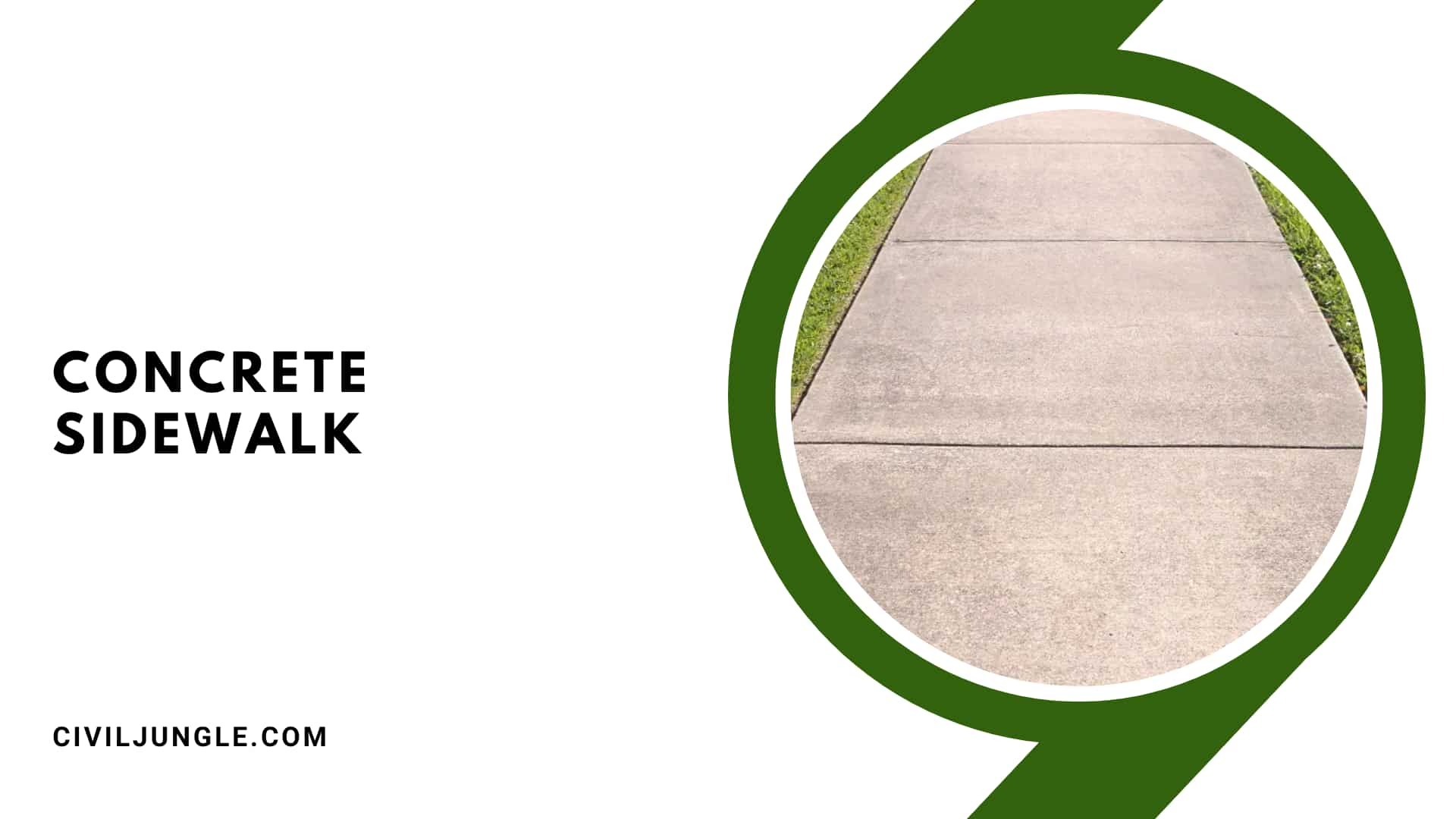
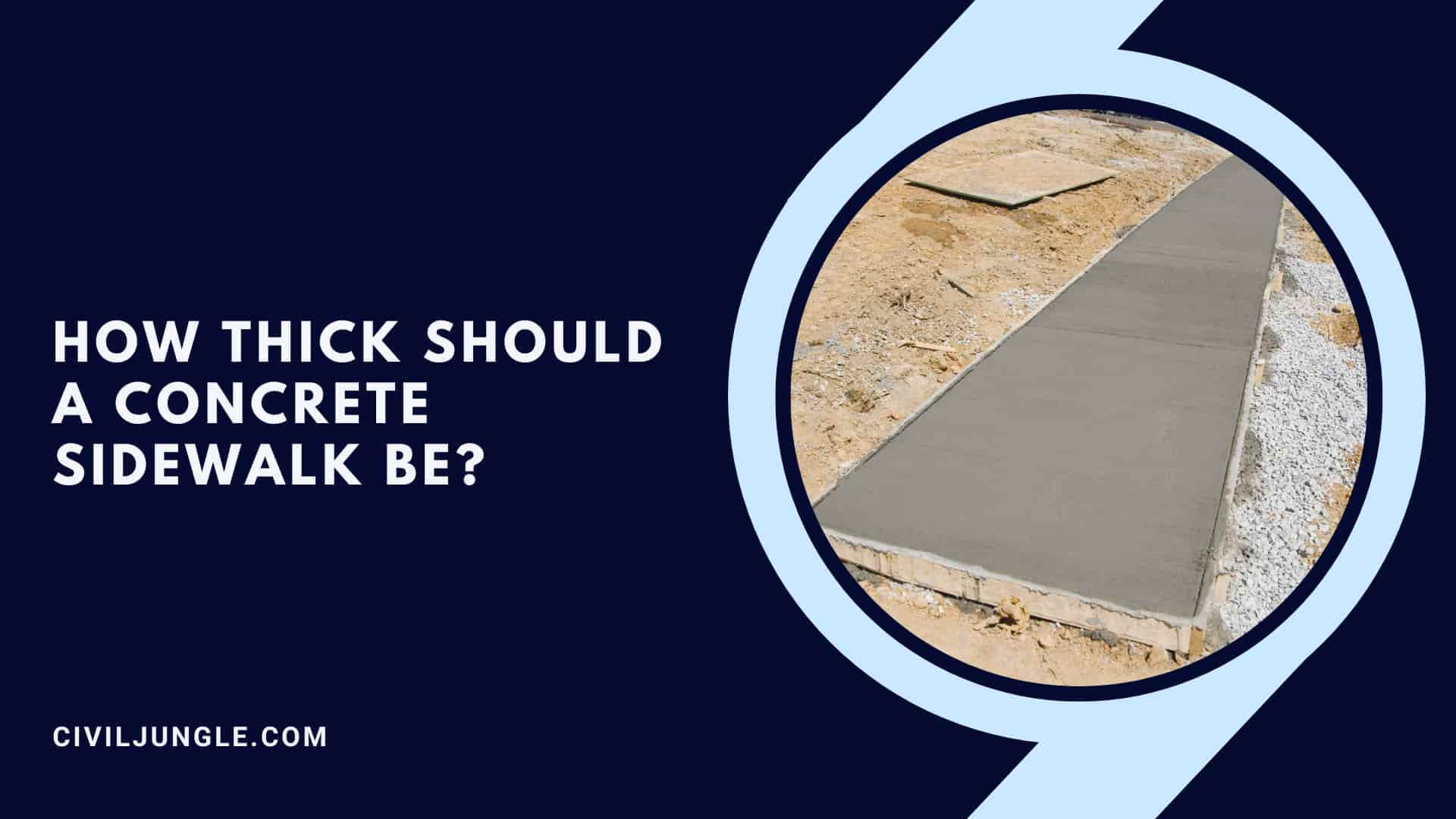
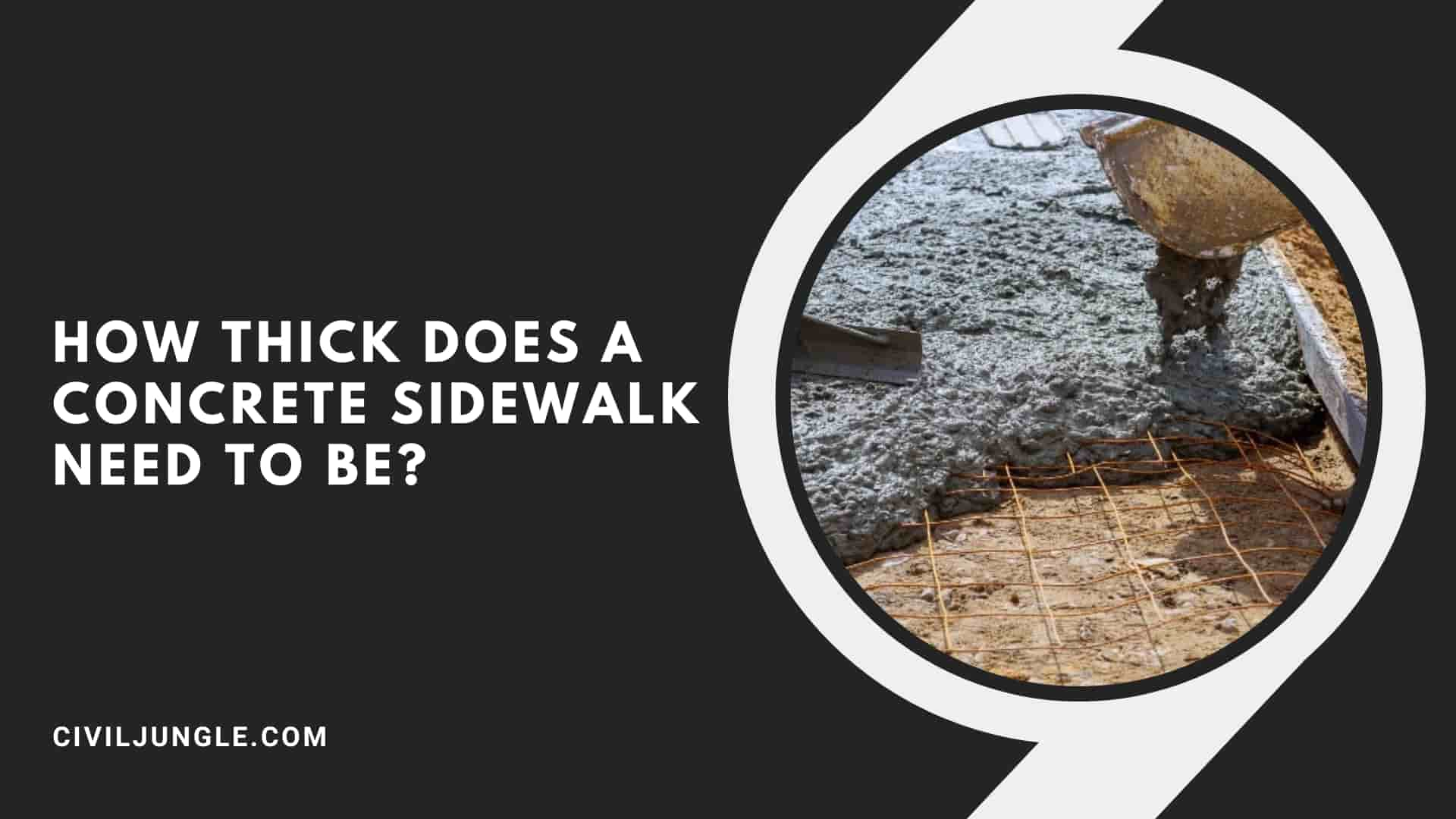
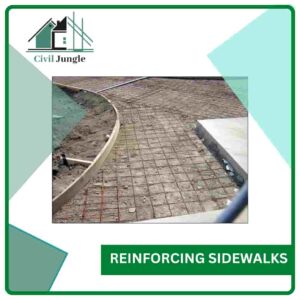


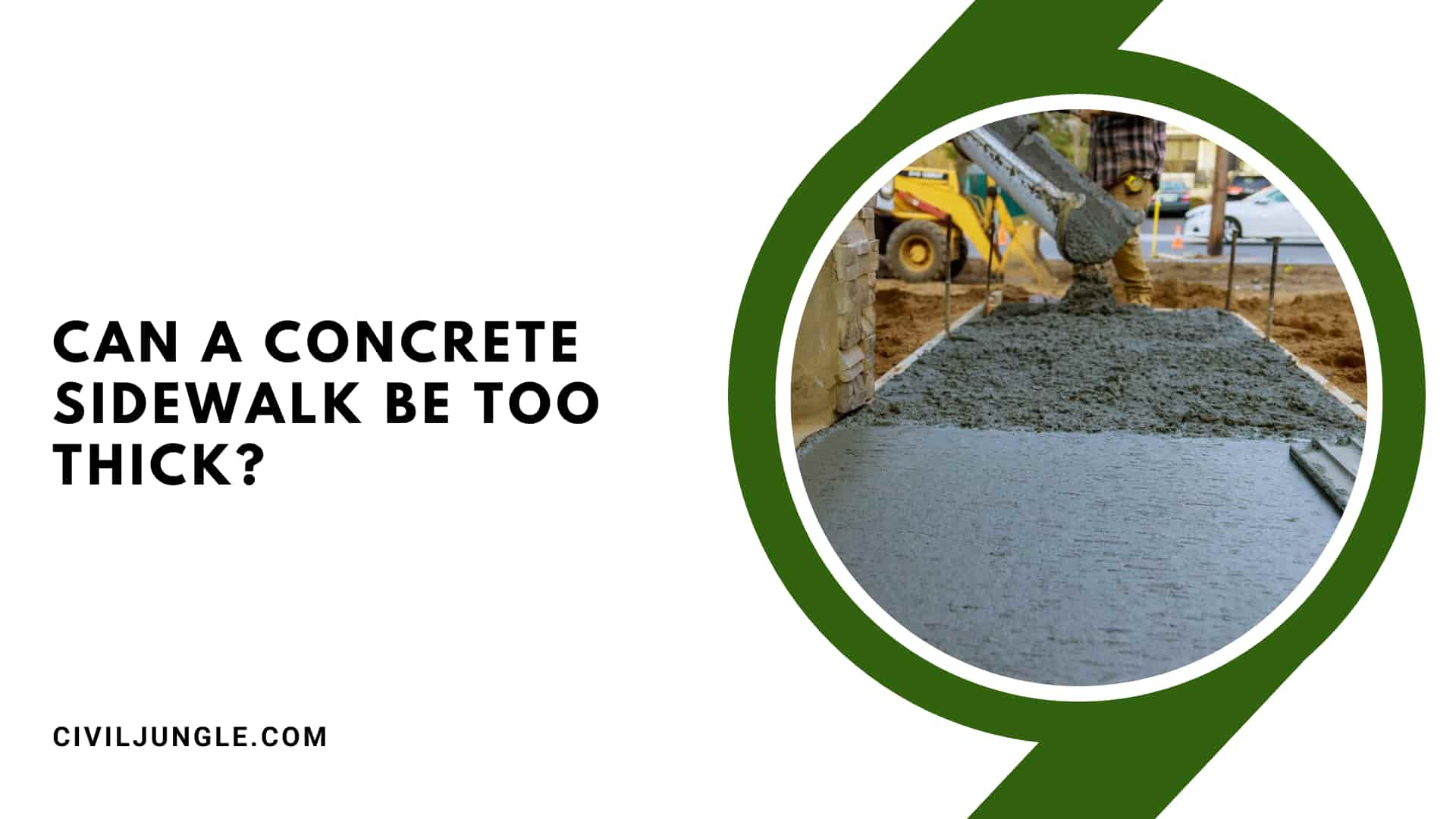

Leave a Reply